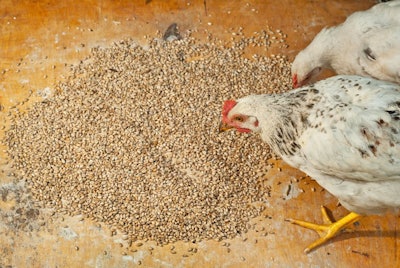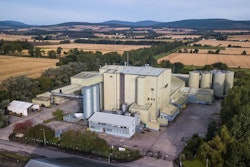
When it comes to replacing corn with wheat in animal diets, it pays to observe the finer details.
In a previous issue, we examined the nutritive value of wheat versus that of corn, especially when the former is considered as a complete replacement for the latter.
In many regions of the world, wheat is used routinely instead of corn to feed all kinds of farm animals. It is thus the lack of local knowledge on how to properly apply wheat in modern formulations that often lead to disappointments when these two cereals are interchanged. As it happens, similar disappointments have been recorded in wheat regions when farmers attempted to use corn.
In this issue, we will examine all remaining aspects of wheat feeding as it regards its non-nutritive characteristics and the peculiarities pertaining to each major class of farm animals, mainly poultry, swine and cattle. As always, the advice of a qualified nutritionist is imperative in commercial enterprises when such drastic changes are in order.
Nutrient variability
This aspect of wheat as a grain is so important that it merits repetition. Nutrients and energy among varieties of wheat can be more variable and the variability so much more unpredictable than what can be expected between wheat and any of the other cereals. This happens because there are so many commercial varieties of wheat that fit specific purposes for human foods. Thus, it is always a priority to at least know what kind of wheat is in the silo. Hard versus soft wheat is a good basis to begin with, but there is more to that, so it is good to ask questions before committing to buying a large lot.
Different mycotoxins
Wheat and corn are raised under different climate conditions. As such, they do not necessarily suffer from the same fungus species and the mycotoxins they produce. Indeed, there may be considerable overlap in some years, but although names of mycotoxins remain the same, their relative concentrations are prone to be widely different between wheat and corn – and this again can vary from year to year. Thus, the same anti-mycotoxin agent used with success in corn-based diets may not work as efficiently, or at all, in wheat-based diets. To this end, it is advisable to test specific wheat batches for their mycotoxin profile and then ask several suppliers as to their best solution.
Particle size of grinding
It is a general rule in animal nutrition that wheat should not be ground too finely. Not only because it is an energy (electricity) inefficient practice, because the same applies to all cereals at varying degree, but mostly because finely ground wheat becomes sticky, easily absorbing air humidity and saliva. Furthermore, finely ground wheat may contribute to severe stomach ulcerations when combined with other stress factors. Plus, finely ground wheat increases dust in the immediate environment of the animals, reducing thus air quality and possibly their health prospects. Depending on animal species, wheat should be ground from medium (600 microns) to coarse (1,200 microns), or just be cracked or even left alone.
Pellet quality
Wheat contains a specific protein, gluten, that is a very good pellet binder. In fact, the finer the particle size the more exposure this protein gets from within the cells, and the higher the binding capacity of wheat. Wheat-based diets make for hard, durable pellets that do not break up easily and create little if any dust particles. As such, wheat is ideal for diets that contain ingredients that are hard to pellet, or for animals that do not chew their pellets (poultry). On the other hand, super hard pellets might be a problem for very young animals (piglets) that chew pellets before swallowing.
Issues with poultry
Meal diets based on finely ground wheat will cause several problems for poultry. The worst is the obstruction of their beaks from sticky feed that becomes caked. This is hard to clean and remove for the birds and, if in excess, birds tend to reduce their feed intake, and consequently they grow slower and less efficiently. In fact, poultry are known to perform well with whole wheat, if this is done correctly, but this is a different feeding approach. Otherwise, wheat, which contains more anti-nutritional factors such as non-starch polysaccharides than corn, tends to affect poultry more than other species. Therefore, it is in poultry that wheat-specific enzymes find the greatest application. This does not mean that all wheat-based diets benefit from such enzymes, but rather when wheat varieties rich in non-starch polysaccharides are used at high concentrations or exclusively, then it is more likely a wheat-specific enzyme will reduce the negative impact of this issue.
Issues with swine
Pigs are more likely to suffer from ulcers when fed finely ground wheat in association with other stress factors. Wheat-specific enzymes appear less effective in pigs than in poultry, for several reasons, whereas hard pellets, which are a bonus for poultry, are actually a detriment for pigs. Especially for very young pigs, research has clearly demonstrated that very hard pellets (virtually with no fines) actually depress feed intake and growth. Thus, for young ages, wheat should be ground coarsely, and only in later stages should wheat particle size be reduced. Plus, meal diets based on finely ground wheat tend to bridge (get stuck) more easily in bins and feeders, whereas feeders quickly become engrossed with caked feed from the interaction of feed with saliva and water.
Issues with cattle
Apart from everything that has been described above regarding nutrient variability and mycotoxins, cattle should be fed with coarsely ground wheat because simply they do not need it to be ground to improve its efficiency. In fact, whole wheat feeding is preferable in certain cases, such as in very intensively raised young beef cattle, where fiber and feed texture are lacking. In fact, in such cases, whole barley is the ingredient of choice. Wheat destined for dairy cows should be monitored very closely for mycotoxins because some of them are able to cross over from the gut to milk, and mycotoxins should not be present in milk. Non-starch polysaccharides in wheat do not appear to affect cattle, as rumen bacteria are fully capable of converting most of them to more useful compounds, but still not as efficiently as starch. Enzymes do not appear to benefit cattle fed wheat-based diets.
In general
The most important issue of wheat in animal diets is its concentration of mycotoxins, which can be much different than those in corn, and its degree of grinding fineness, which affects pellet quality and the animal’s ability to consume feed. Cracked or whole wheat feeding is an interesting practice, and there is a considerable volume of literature on the topic, worth investigating in the case of poultry and perhaps even ruminants.
In the end, sufficient characterization of wheat is key to successfully feeding it to any class of animals, and the same is true for any ingredient.

















